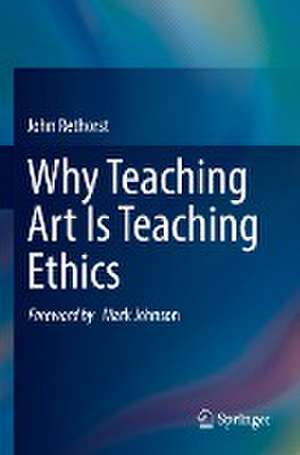Why Teaching Art Is Teaching Ethics
Autor John Rethorsten Limba Engleză Paperback – 3 ian 2024
If moral thinking is simply logical reasoning or following God-given law, why did the poet Shelley say that “the great instrument of moral good is the imagination”? Why does ethical reasoning tend towards absolutes: something is either right or wrong, period, while a thoughtful minority values the “priority of the particular” – that unique aspects of a situation may come closer to the heart of the matter than any general rules could? Are emotions, as many philosophers in history have theorized, only a distraction from the clear perception of duty, or do feelings add something important, even critical, to how we judge good and bad, right and wrong? Can great works of art and literature embody imagination, the particular, and emotions to illuminate human life in ways crucial to ethical thinking? This book introduces an original idea in philosophy, “moral density,” which for the first time elucidates the profound relation between art and ethics. Written for the literate layperson, an academic or technical background is not necessary, so this book will be of interest not only to philosophers and educators, but to all who are concerned with what is good, and how to see it and teach it.
| Toate formatele și edițiile | Preț | Express |
|---|---|---|
| Paperback (1) | 521.79 lei 6-8 săpt. | |
| Springer Nature Switzerland – 3 ian 2024 | 521.79 lei 6-8 săpt. | |
| Hardback (1) | 527.79 lei 6-8 săpt. | |
| Springer Nature Switzerland – 2 ian 2023 | 527.79 lei 6-8 săpt. |
Preț: 521.79 lei
Preț vechi: 613.86 lei
-15% Nou
Puncte Express: 783
Preț estimativ în valută:
99.85€ • 103.01$ • 83.32£
99.85€ • 103.01$ • 83.32£
Carte tipărită la comandă
Livrare economică 26 martie-09 aprilie
Preluare comenzi: 021 569.72.76
Specificații
ISBN-13: 9783031195136
ISBN-10: 3031195132
Ilustrații: XIII, 162 p. 2 illus.
Dimensiuni: 155 x 235 mm
Greutate: 0.26 kg
Ediția:1st ed. 2023
Editura: Springer Nature Switzerland
Colecția Springer
Locul publicării:Cham, Switzerland
ISBN-10: 3031195132
Ilustrații: XIII, 162 p. 2 illus.
Dimensiuni: 155 x 235 mm
Greutate: 0.26 kg
Ediția:1st ed. 2023
Editura: Springer Nature Switzerland
Colecția Springer
Locul publicării:Cham, Switzerland
Cuprins
Utility, Principle, Virtue.- Particularism.- Perception and Representation.- Imagination and Metaphor.- Aesthetic Illumination.- Literary Expression.- Aristotle and Jane Austen.- Directions.
Notă biografică
John Rethorst has taught at Cornell University and other colleges and schools in the United States and Europe. Beyond the academic community, he has been a railroad telegraph operator, newspaper reporter and photographer, a sailor on a polar icebreaker, has worked on a dairy farm, written computer software, and lived and studied in a Zen Buddhist monastery.
Textul de pe ultima copertă
This exhaustively-researched, carefully-focused book asks whether imagination, emotion and art can enlighten our sense of right and wrong, looking at this question through the lens of moral philosophy with contributions from cognitive science, psychology and neurology.
If moral thinking is simply logical reasoning or following God-given law, why did the poet Shelley say that “the great instrument of moral good is the imagination”? Why does ethical reasoning tend towards absolutes: something is either right or wrong, period, while a thoughtful minority values the “priority of the particular” – that unique aspects of a situation may come closer to the heart of the matter than any general rules could? Are emotions, as many philosophers in history have theorized, only a distraction from the clear perception of duty, or do feelings add something important, even critical, to how we judge good and bad, right and wrong? Can great works of art and literature embody imagination, the particular, and emotions to illuminate human life in ways crucial to ethical thinking? This book introduces an original idea in philosophy, “moral density,” which for the first time elucidates the profound relation between art and ethics. Written for the literate layperson, an academic or technical background is not necessary, so this book will be of interest not only to philosophers and educators, but to all who are concerned with what is good, and how to see it and teach it.
If moral thinking is simply logical reasoning or following God-given law, why did the poet Shelley say that “the great instrument of moral good is the imagination”? Why does ethical reasoning tend towards absolutes: something is either right or wrong, period, while a thoughtful minority values the “priority of the particular” – that unique aspects of a situation may come closer to the heart of the matter than any general rules could? Are emotions, as many philosophers in history have theorized, only a distraction from the clear perception of duty, or do feelings add something important, even critical, to how we judge good and bad, right and wrong? Can great works of art and literature embody imagination, the particular, and emotions to illuminate human life in ways crucial to ethical thinking? This book introduces an original idea in philosophy, “moral density,” which for the first time elucidates the profound relation between art and ethics. Written for the literate layperson, an academic or technical background is not necessary, so this book will be of interest not only to philosophers and educators, but to all who are concerned with what is good, and how to see it and teach it.
Caracteristici
Considers in detail why art is, as Plato thought, the nearest clue to ethics Discusses in detail how literature can provide moral illumination Brings traditional and current thinking in both philosophy and education, to help young people become good people
